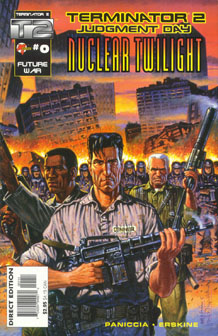“All My Future’s Past” (1990) chronicled the time travel that led to the events of “The Terminator,” but then the sequel and a bunch of new comics made that story apocryphal (unless, perhaps, you factor in rewritten or alternate timelines). The “updated” version of the time travel leading up to both movies and “Cybernetic Dawn” is Malibu’s “Nuclear Twilight” (1995-96).
It’s also a richer yarn than the two-issue “AMFP,” in part because it gets five issues (numbered 1-4, then with Issue 0 – which is combined with “Cybernetic Dawn” Issue 0 — concluding the tale). Writer Mark Paniccia weaves one of the smartest “Terminator” yarns to date as it ties in with “Cybernetic Dawn” and the movies. But it has room for surprises: I like the parallel narrative of Skynet capturing resistance soldier Griff and having a T-1000 take his place even as the resistance captures an endoskeleton and programs it with a virus.
The art by Gary Erskine is slick and professional. Although his art isn’t quite as cinematic as “Cybernetic Dawn,” he nails the likeness of Future John as portrayed by Michael Edwards in “T2.” The Reese likeness could’ve been better, but I was never confused as to what’s going on, in part because all the soldiers conveniently have their names on their shirts and helmets.
CHARACTERS
John Connor: The leader of the human resistance in the U.S. He balances being protective of Kyle with not letting Kyle know he’s being protective of him. John is secretive, confiding only in his best friend, Danny Dyson. Luckily, he’s respected enough that no one – except Kyle — chafes at his secrecy.
Sarah Connor: She’s in the war scenes in the early Aughts, then disappears from the narrative.
Kyle Reese: As per classic “Terminator” lore, John knows Kyle is his dad and that Kyle will volunteer for the time-travel mission. Kyle is an excellent soldier who is peeved that John pulls him off a mission for (apparently) no good reason.
Danny Dyson: The son of Miles Dyson, and John’s best friend. He’s John’s main confidante and the only person completely in the loop on John’s plan to send Kyle back in time. Danny also devises a virus to infiltrate Skynet’s headquarters at Cheyenne Mountain, Colo. (Danny’s mom and sister are around in the early Aughts, but presumably they don’t survive until 2029.)
Colonel Mossberg: The former LAPD detective is now a trusted resistance leader who works closely with John.
Jonathan Ellis Reese: John meets this man early in the war and suspects he might go on to be the father of Kyle (and thus John’s grandfather).
TERMINATORS
T-800, model 101s: The familiar endoskeletons are given this designation here. I had been under the impression that T-800s were the infiltrator model with living tissue on the outside and that 101 was Arnold’s model number. In “Nuclear Twilight,” these Terminators can operate in “hive mode” (controlled by Skynet) or “rogue mode” (powered by an internal battery). Issue 2 brings up a little-discussed (yet logical) point that T-800s were “originally created to save human lives” before Skynet gained sentience.

T-1000s: One unit of note takes the form of a resistance soldier named Griff and restarts Skynet on the final page after the resistance has shut it down.
CONTINUITY
“Nuclear Twilight” is the sequel to “Cybernetic Dawn.” It opens with a few scenes in the early days of the Future War (after the foretold Judgment Day of 1997), in the early Aughts. “We celebrated the new millennium by counting a few less clicks on the jimmy-rigged surface Geiger counters,” John narrates. After this flashback segment, the bulk of “Nuclear Twilight” occurs in 2029.
The resistance’s hidey-holes have traditionally been war-ravaged underground tunnels. The one in “Nuclear Twilight” is by far the nicest – it looks like a sterile military barracks, complete with clean hallways and assigned rooms.
“Nuclear Twilight” picks up on Danny’s childhood idea of infecting Skynet with a virus. He’s been perfecting the virus through the decades, using the endoskeleton head from the final issue of “Cybernetic Dawn.” The resistance installs this head, nicknamed “Rusty,” onto an endoskeleton they’ve captured.
“Nuclear Twilight” gives us more concise term for “time traveling via a time-displacement equipment platform”: chronoportation. I like it.
This comic finally chronicles the resistance’s 2029 attack on Skynet’s HQ. It was referenced in “AMFP,” as John had to sync his mission with what was going on in Colorado, but here we actually see the Cheyenne Mountain mission. We also saw an attack on Skynet’s HQ in “The Burning Earth,” but that was in 2041 in Nevada, and probably on a different version of the timeline.
The conclusive Issue 0 gives us the first thorough portrayal (although it was touched upon in the “T2” novelization) of the reprogramming and sending back of the T-800. The good T-800 – with its newly installed chip (the one John picked up back in 1995 in “Cybernetic Dawn”) — fights off several evil ones, thus proving that the reprogramming works.
While I can understand that John was stressed out by the events of the day, there is actually a moment of calm before he sends the T-800 back. John perhaps should’ve used this time to brief the unit with tons of information that would be useful to the Past John so he’s not doing so much guesswork on the next pass through the timeline.
At the story’s end, the T-1000 in the guise of Griff restarts Skynet at Cheyenne Mountain even as the resistance soldiers celebrate outside the stronghold. This could explain the events of the Dark Horse 1984 saga, where Skynet continued to exist and where several chronoportations happened three months after the chronoportations we know from the movies. Or perhaps Skynet’s new life leads to the events of the Now Comics, where the war continued until 2041.
TIME TRAVEL
All the time travelers from the two movies and “Cybernetic Dawn” initiate their time travel in this series. (The time travel from Dark Horse is ignored, but not necessarily impossible in this narrative.)
“Nuclear Twilight” only focuses on one TDE facility, but that doesn’t necessarily preclude the existence of other facilities. Indeed, the three Terminators in “Cybernetic Dawn” materialized in the middle of a highway – suggesting they came from different location from the main TDE facility.
Evidence for “fate”:
- Judgment Day happens on Aug. 29, 1997, the exact same date as in the history known by the reprogrammed T-800 in “T2.”
- The resistance techs detect several “power dips” from the Skynet grid. John correctly surmises Skynet has invented time travel and is firing up its TDEs. In “Cybernetic Dawn,” we learned that Skynet sent at least 27 (and probably many more, as those 27 units were just the ones that failed to report in) endoskeletons back in time as tests. The power dips probably correlate with that.
- Everything leading up to Kyle’s (Issue 4) and the good T-800’s (Issue 0) chronoportation goes as John expects it to, notably Kyle volunteering for the mission. He didn’t know beforehand that Danny was going to prove crucial to killing Skynet and reprogramming the T-800, but nonetheless, everything snaps into place nicely.
- The “Griff” T-1000 restarting Skynet makes the Dark Horse stories possible. Even though the writers almost certainly didn’t intend to incorporate DH’s work, perhaps fate made them tie it all together anyway.
Evidence that “the future is not set”:
- “Nuclear Twilight” tells the classic TDE story from “All My Future’s Past” and the “T2” book, but with different sequences of events and different supporting characters. Perhaps these three stories are on different versions of the timeline.
- What we’ve previously called the TDE facility or TDE fortress is known here as “the California annex” or “the time-jump facility.” A minor issue, but it could be that different terminology catches on in different versions of the timeline.
- The TDE building looks like a smaller version of the Massassi Temple in “Star Wars.” In the Dark Horse comics, it looks like a nuclear power plant, and in “AMFP” it looks like a gigantic chess pawn. And whereas “AMFP” clearly delineates the existence of two platforms within the main facility, “Nuclear Twilight” is less clear on the issue (although by the geographic logic of the movies, there have to be at least two distinct platforms). Different versions of the timeline might explain the alterations in architecture.
- In Issue 2, we’re told Cyberdyne’s stronghold is in Wyoming, but later issues reveal this to be an apparent editing mistake, as the stronghold is in Cheyenne Mountain, Colo. Even so, in other yarns the stronghold has been located in Montana (the regular Now Comics series) and Nevada (“The Burning Earth”). Maybe Skynet has a different stronghold in different versions of the timeline.
- John’s best buddy is Danny Dyson. The Now Comics tell us his best friend, going all the way back to his childhood, is Miguel De Verona. Yet again, different versions of the timeline – which come about from time travel that makes a new future possible — might be the explanation.

